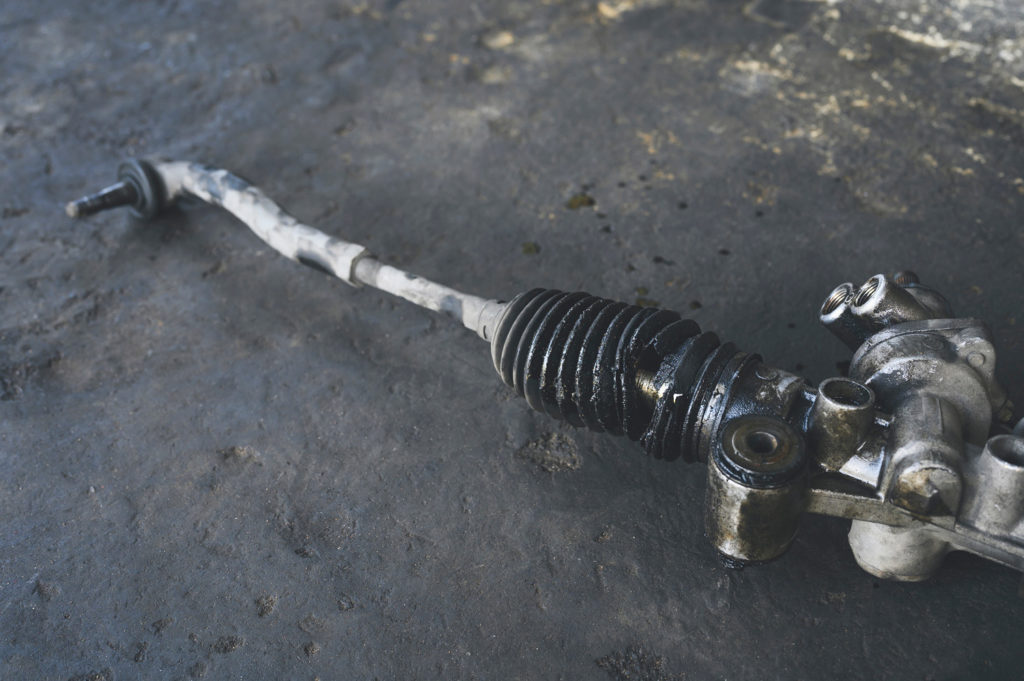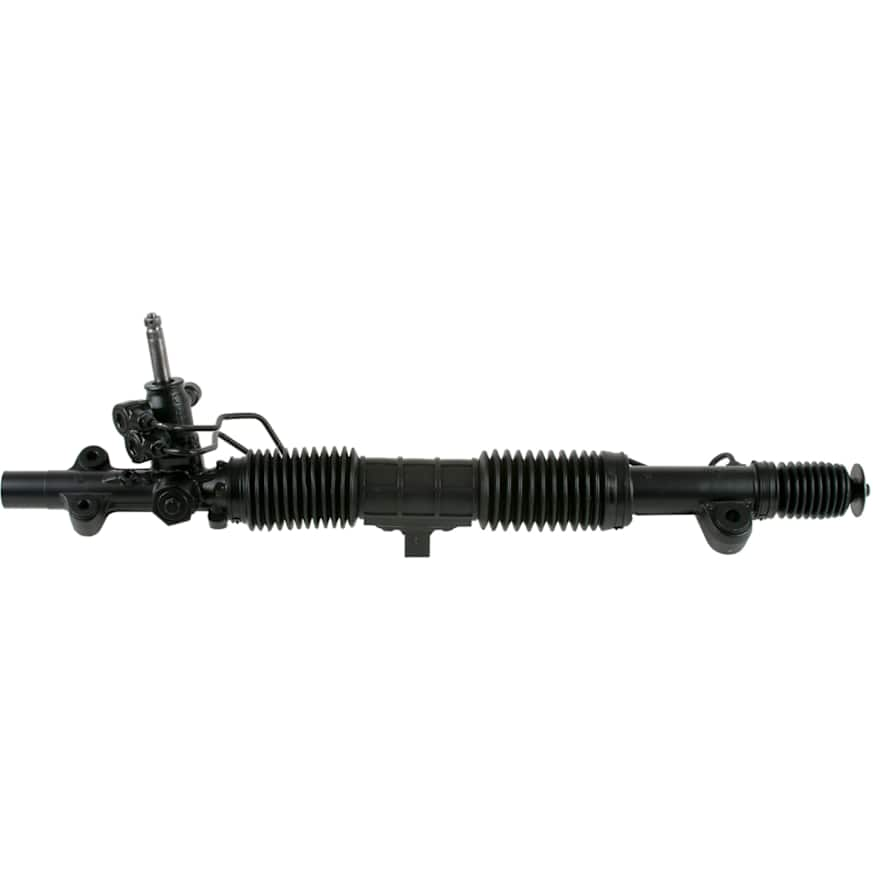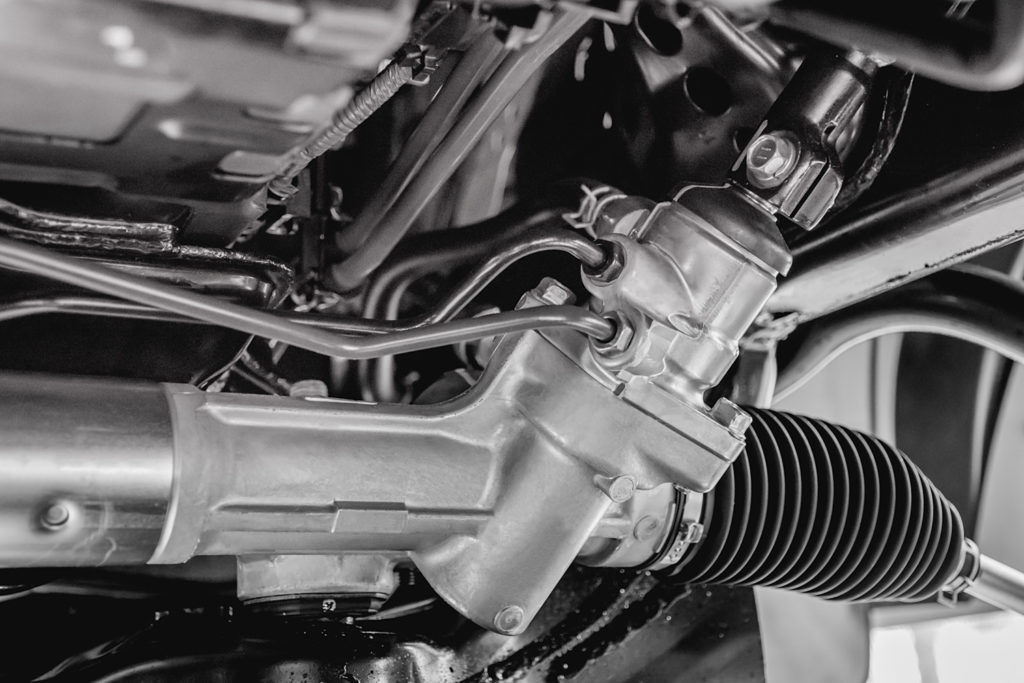The steering system has a rack gear and pinion gear that are responsible for transforming the rotational motion from the steering wheel into the linear motion needed to turn the wheels.
What Is a Steering Rack?
The steering rack is part of your vehicle’s steering system and allows your wheels to rotate from side to side when you turn your steering wheel.
The steering rack is also called the rack and pinion assembly. The pinion gear receives the turning motion from the steering wheel and pushes the geared rack left or right. The geared rack then pushes one tie rod and pulls the other. This motion allows the vehicle to turn, since the tie rods control the wheels’ steering angle.
How Does a Steering Rack Work?
Aside from turning rotational motion into linear motion, the steering rack is also an important component in the vehicle’s power steering system. The steering rack uses hydraulic fluid and an internal piston to make steering easier for the driver.

When the driver makes inputs, the hydraulic fluid pushes the piston towards the direction of the turn. This helps push the weight of the wheels and the steering assembly. The amount of assistance the driver gets is relative to the hydraulic pressure exerted by the pump. A part called the rotary control valve located in the steering column determines the amount of hydraulic pressure that reaches the steering rack.
Thanks to the rotary control valve, the amount of hydraulic assistance provided by the hydraulic fluid pump is proportional to the amount of torque exerted by the driver. This allows the steering system to only provide assistance when the driver is turning the wheel.
The steering rack is also able to reduce the force needed to turn the wheels by providing gear reduction. Gear reduction is the reason why drivers need to turn the steering wheel many times to make a sharp turn. The amount of rotation varies from vehicle to vehicle because steering ratios depend on the vehicle type. Lighter, sportier cars typically have lower steering ratios, which means drivers don’t have to turn their steering wheels a lot to turn the wheels. Sports cars can get away with a low steering ratio because they’re lightweight and have less need for gear reduction.

What Are the Symptoms of a Worn Steering Rack?
Steering is very important when it comes to driving safely. Detecting the symptoms of a worn steering rack is important because a faulty steering rack can compromise your ability to control your vehicle. Common steering rack issues include the following:
Leaking Power Steering Fluid
The hydraulic fluid inside the steering rack exerts a lot of pressure on the steering rack’s valves, pistons, and o-rings. As time passes, its seals and valves can wear out and leak. When fluid levels decrease as a result of the leak, you’re likely going to feel a heavier-feeling steering wheel. At the same time, less fluid in the steering rack will cause more heat to build up and can lead the steering rack’s gears to break apart.
You should regularly check your steering fluid to see if it’s topped off. If you have to refill your steering fluid regularly, then it might be leaking. If so, then you might see traces of power steering fluid beneath your vehicle.
Tight Steering
When the steering wheel feels tight or difficult to turn, it might be due to excessive wear in the steering rack or gearbox, or a loss of hydraulic pressure. Since difficult turning can also be caused by a lack of power steering fluid, it’s possible that adding more power steering fluid will solve the problem. Keep in mind, however, that if the fluid is low, that means there’s a leak somewhere that you’ll need to fix.

Noises from the Steering System
The steering rack sometimes makes noises when it’s malfunctioning. If you turn the steering wheel and hear clunking, grinding, or thudding, it’s possible that the steering gearbox has internal wear. When metal on metal contact occurs in the power steering system, metal filings are created and mixed in the power steering fluid. These metal filings can work their way through the system, causing other parts of the system to fail prematurely. Before any replacement parts are installed, the dirty fluid needs to be thoroughly flushed and replaced.
If your vehicle shows any of the symptoms listed above, visit your trusted mechanic immediately and ask them to inspect your vehicle. We don’t recommend driving with a faulty steering rack. You should ask a certified mechanic to check this issue out and fix it as soon as possible.
How Much Does a Replacement Steering Rack Cost?
Steering racks can cost anywhere between $30 and $1000. The large price range is determined by many factors such as the steering rack’s brand, design, and intended vehicle model.
Any information provided on this Website is for informational purposes only and is not intended to replace consultation with a professional mechanic. The accuracy and timeliness of the information may change from the time of publication.
































